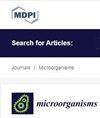用生物表面活性剂稳定的银纳米粒子的合成与表征及其作为抗菌剂的应用
IF 4.1
2区 生物学
Q2 MICROBIOLOGY
引用次数: 0
摘要
表面活性剂可用作纳米粒子稳定剂。然而,由于合成表面活性剂既不经济又不环保,生物表面活性剂正成为合成和稳定纳米粒子的绿色替代品。纳米粒子已被应用于多个工业领域,如生物医学和治疗元件的生产、包装涂层、太阳能发电和电能输配等。本研究的目的是使用由脂肪分解念珠菌 UCP 0899 产生的生物表面活性剂作为稳定剂,以简单、绿色的方式合成银纳米粒子(AgNPs)。利用紫外可见光谱(UV-visible)、扫描电子显微镜(SEM)、ZETA 电位和能量色散 X 射线光谱(EDS)等技术对 AgNPs 进行了检测和形态表征。新形成的银纳米粒子在 400 纳米波长处显示出最大紫外可见吸收峰,而储存 120 天的银纳米粒子则向 410 纳米波长处移动。扫描电子显微镜显微照片证实,形成的纳米粒子平均尺寸为 20 纳米,主要呈球形结构,Zeta 电位为 -60 mV,表明生物表面活性剂的使用提高了纳米粒子的稳定性。稳定的纳米颗粒对铜绿假单胞菌、金黄色葡萄球菌、大肠杆菌和肠杆菌等细菌分离物以及白色念珠菌和黑曲霉等真菌分离物进行了抗菌活性测试。在 16.50 微克/毫升的浓度下,AgNPs 可抑制所有目标微生物的生长,抑制率依次递减:大肠杆菌(95%)、金黄色葡萄球菌、白僵菌(90%)、黑曲霉(85%)、肠杆菌(75%)和绿脓杆菌(71%)。这些结果表明,生物表面活性剂可作为银纳米粒子的稳定剂,在不同的工业领域用作抗菌剂。此外,还利用褐斑天牛模型评估了生物表面活性剂的体内毒性潜力。幼虫经浓度为 2.5、5.0 和 10 克/升的生物表面活性剂处理后,在 24 至 72 小时内未观察到死亡现象,表明在测试浓度范围内无毒性。这些研究结果证明了生物表面活性剂稳定纳米粒子的安全性、有效性和无毒性。本文章由计算机程序翻译,如有差异,请以英文原文为准。
Synthesis and Characterization of Silver Nanoparticles Stabilized with Biosurfactant and Application as an Antimicrobial Agent
Surfactants can be used as nanoparticle stabilizing agents. However, since synthetic surfactants are not economically viable and environmentally friendly, biosurfactants are emerging as a green alternative for the synthesis and stabilization of nanoparticles. Nanoparticles have been applied in several areas of industry, such as the production of biomedical and therapeutic components, packaging coating, solar energy generation and transmission and distribution of electrical energy, among others. The aim of this study was to synthesize, in a simple and green way, silver nanoparticles (AgNPs) using the biosurfactant produced by Candida lipolytica UCP 0899 as a stabilizer. AgNPs were examined and morphologically characterized using the techniques of ultraviolet–visible spectroscopy (UV–visible), scanning electron microscopy (SEM), zeta potential and energy dispersive X-ray spectroscopy (EDS). Newly formed silver nanoparticles showed a maximum UV–visible absorption peak at 400 nm, while a shift to 410 nm was observed in those stored for 120 days. SEM micrograph confirmed the formation of nanoparticles with an average size of 20 nm and with a predominant spherical structure, while a zeta potential of −60 mV suggested that the use of the biosurfactant promoted their stability. Stabilized nanoparticles were tested for their antimicrobial activity against bacterial isolates of Pseudomonas aeruginosa, Staphylococcus aureus, Escherichia coli and Enterobacter sp., as well as fungal isolates of Candida albicans and Aspergillus niger. At a concentration of 16.50 µg/mL, AgNPs inhibited the growth of all target microorganisms according to the following decreasing order: E. coli (95%), S. aureus, C. albicans (90%), A. niger (85%), Enterobacter sp. (75%) and P. aeruginosa (71%). These results suggest the potential use of the biosurfactant as a stabilizer of silver nanoparticles as an antimicrobial agent in different industrial sectors. Furthermore, the in vivo toxicity potential of biosurfactants was evaluated using the Tenebrio molitor model. The larvae were treated with concentrations in the range of 2.5, 5.0 and 10 g/L, and no mortality was observed within the 24 to 72 h period, demonstrating non-toxicity within the tested concentration range. These findings support the safety, efficacy and non-toxicity of biosurfactant-stabilized nanoparticles.
求助全文
通过发布文献求助,成功后即可免费获取论文全文。
去求助
来源期刊

Microorganisms
Medicine-Microbiology (medical)
CiteScore
7.40
自引率
6.70%
发文量
2168
审稿时长
20.03 days
期刊介绍:
Microorganisms (ISSN 2076-2607) is an international, peer-reviewed open access journal which provides an advanced forum for studies related to prokaryotic and eukaryotic microorganisms, viruses and prions. It publishes reviews, research papers and communications. Our aim is to encourage scientists to publish their experimental and theoretical results in as much detail as possible. There is no restriction on the length of the papers. The full experimental details must be provided so that the results can be reproduced. Electronic files and software regarding the full details of the calculation or experimental procedure, if unable to be published in a normal way, can be deposited as supplementary electronic material.
 求助内容:
求助内容: 应助结果提醒方式:
应助结果提醒方式:


